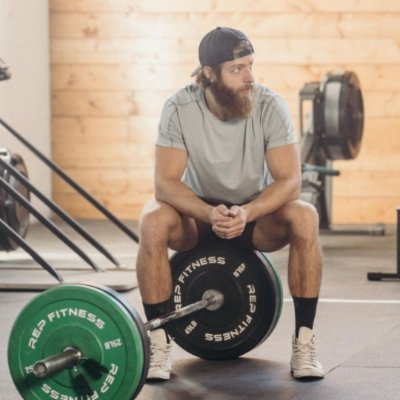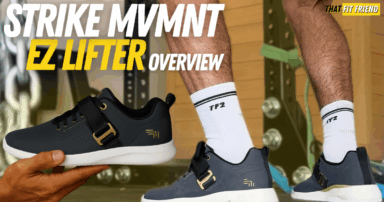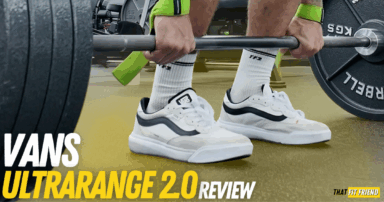That Fit Friend is supported by its readers. I [Jake Boly] run this site myself and buy the gear I review. If you purchase through my site, I may earn commissions on sales, read more here!
The Under Armour Project Rock 3 is the third iteration in the popular Project Rock training shoe line. This model has multiple Under Armour construction traits that give it a proprietary feel and comes with The Rock’s signature branding. Despite this model having a cool aesthetic, the real question is, how does it perform?
In this Under Armour Project Rock 3 review, I put this model through a variety of tests to assess if it’s worth the money and if it can hold up in versatile training. Also, make sure you check out my UA Project Rock 4 review and the comparison article where I discuss why the 4 is better than the 3.
Who Should Buy the UA Project Rock 3
The UA Project Rock 3 training shoes will not be for everyone. However, if you’re someone who truly loves The Rock and his brand and mission, and don’t mind the higher price tag, then I don’t think you’ll regret buying this model.
This shoe is great for recreational training (lifting, agility, lighter runs) and is comfortable on a day-to-day basis. If these performance categories sound like you, then this shoe will be solid for you. Remember though, check out the sizing before buying.
UA Project Rock 3 Pros
There are four things that I really enjoy about Project Rock 3 when it comes to performance and general fit and feeling.
- UA HOVR Midsole
- UA TriBase Outsole
- Reworked Upper
- Additional Heel Material
The first two aspects that I like about this model is the signature UA HOVR Midsole and TriBase outsole. Whenever UA uses HOVR midsole technology in their shoes, then you can expect a model with solid responsiveness and a decent level of stability. In addition, the TriBase outsole is fantastic for providing a stable base to create a tripod foot position with (tripod = grounding the base of the big toe, pinky toe, and base of heel).
The second aspect that I like about this model — and this is only really relevant for folks who have worn the Project Rock 2 — is the reworked upper. This model has a knit and synthetic mesh upper that provides breathability, durability, and feels very natural on the foot.
The final aspect that I like, in theory, is the additional heel material. The Project Rock 3 is a bootie-style shoe and in this model, UA added an additional counter on the heel for comfort and heel slip prevention. I do enjoy this aspect, however, it messes up the sizing of this model, which also makes it a con that I’ll elaborate on below.
UA Project Rock 3 Cons
Despite enjoying this model as a whole, there are a few cons and drawbacks that I think you should note before buying.
- Odd Sizing
- A lot of Midsole
- Price
As mentioned above, the additional heel material is great in theory, but it makes the sizing of this model tricky. If you’re looking into this model, then expect to size up a half to full size. The heel material pushes the foot forward a fair amount and creates some toe jamming when the sizing isn’t right.
Another potential con with this model is the overall stability. I enjoy the HOVR midsole, but there is context here worth noting. As a general trainer, the midsole is great. Conversely, as a hardcore, stable trainer, this midsole is likely not the best option out there for the lifter who wants to train heavily in this model.
The final drawback is the price. With a price tag of $140, the UA Project Rock 3 is far from being a cost-efficient model. That’s why I want to stress that if you buy this model, make sure you enjoy The Rock branding and vision use it for general training, and take care of it to get the most out of it.
When assessing the UA Project Rock 3’s performance, I test multiple characteristics to help provide you with a full lay of the land for if this shoe would be a good fit for you.
Lifting
When it comes to lifting, the UA Project Rock 3 does an adequate job with external loading. Would it be my top pick for stability? No. However, I think for most, this model will provide plenty of support. I worked up to 450 lbs in this model with high-rep trap bar deadlifts and it did an “okay” job at providing stability.
The Project Rock 3 is what you would expect from a training shoe with a thicker midsole and slightly higher heel-to-toe drop (8mm). If you don’t plan to train super heavy in this model, then it should work perfectly fine for most lifting activities.
Agility and Plyometrics
For agility and plyometric work, this model is once again okay. It does a fairly good job at promoting this style of performance, but it’s not going to be super niche-focused like other models. I like the lightweight nature of this shoe and its bootie design.
Additionally, I think the HOVR midsole does a good job at promoting responsiveness while the TribBase outsole helps to ground the foot. These are both positive aspects when focusing on multi-directional training.
Day-to-Day and Shorter Runs
From a day-to-day point of view, I really like this trainer. It’s comfortable and I think if you’re someone that wants to rock these for errands, chores, at the office/work, and to do general activities in, then you’ll like them.
For runs, this model is also fairly good compared to other trainers on the market. The 8mm heel-to-toe drop plays into this style of training well and the HOVR midsole once again provides a fairly comfortable ride. I think you could rock this model for shorter and mid-range runs (1-6ish miles) and find it fairly comfortable.
Sizing and Fit
When it comes to sizing and fit for the UA Project Rock 3, I’d stress to be meticulous with what size you choose. If you can, try them on before you buy them. However, if that’s not a possibility for you, then I’d suggest going up a half to full-size from your normal size.
The additional heel material is going to push your foot forward, so if you’re usually maxing out your normal shoes, then opt for a full size bigger. For anyone that generally has a bit of toe room in their normal shoe, then a half size will suffice.
Price
I’ve mentioned the price above, but for the UA Project Rock 3, you can expect to pay around $140 USD. Compared to other cross-training shoes, this price point is far from cost-efficient. If you want a Project Rock model and want to save a little money, then I’d suggest looking at the budget BSR option or older models.
Construction Details
For my detail-focused friends, I’ve listed out all of the construction details from Under Armour’s site for the Project Rock 3 below.
- UA HOVR™ technology provides ‘zero gravity feel’ to maintain energy return that helps eliminate impact
- Compression mesh Energy Web contains & molds UA HOVR™ foam to give back the energy you put in
- UA Tribase™ maximizes ground contact, promotes natural motion & provides flexibility to grip during lifts
- Upper is extremely comfortable & durable, while providing stability & containment where you need it
- Unique lacing structure for a locked-in fit & feel
- Updated, knit bootie construction for a snug, comfortable fit
- External heel counter combined with stability chassis creates the ultimate in stable support
- Full rubber outsole for elevated traction & durability
There are a lot of changes compared to the Project Rock 2, so if you liked that model, then expect plenty of differences with this iteration.
Is This Model for You?
The UA Project Rock 3 is a pretty consistent shoe across the board when it comes to performance. If you like The Rock and his product line and don’t mind the price tag, then, I think this model will be a good fit for you.
I think this model is a step up from the Project Rock 2, but be warned, make sure you nail the sizing to get the most out of this shoe.









Bernie Dillon
What’s the best cross trainer for cushion and stability?
All of the following models can be used for hitting around 400 lbs and have a decent level of cushion to them. The Project Rocks are okay (I’d say go PR4 if you’re interested in them), Nano X1 works well, Metcon 7 has a bit more cushion than previous models, and I also really like the STR/KE MVMNT Haze Trainer. How heavy do you plan on training? That could help me suggest better models per your needs!